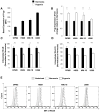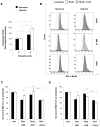Tariquidar sensitizes multiple myeloma cells to proteasome inhibitors via reduction of hypoxia-induced P-gp-mediated drug resistance
- PMID: 28509582
- PMCID: PMC6056270
- DOI: 10.1080/10428194.2017.1319052
Tariquidar sensitizes multiple myeloma cells to proteasome inhibitors via reduction of hypoxia-induced P-gp-mediated drug resistance
Abstract
Multiple myeloma (MM) presents a poor prognosis and high lethality of patients due to development of drug resistance. P-glycoprotein (P-gp), a drug-efflux transporter, is upregulated in MM patients post-chemotherapy and is involved in the development of drug resistance since many anti-myeloma drugs (including proteasome inhibitors) are P-gp substrates. Hypoxia develops in the bone marrow niche during MM progression and has long been linked to chemoresistance. Additionally, hypoxia-inducible transcription factor (HIF-1α) was demonstrated to directly regulate P-gp expression. We found that in MM patients P-gp expression positively correlated with the hypoxic marker, HIF-1α. Hypoxia increased P-gp protein expression and its efflux capabilities in MM cells in vitro using flow cytometry. We reported herein that hypoxia-mediated resistance to carfilzomib and bortezomib in MM cells is due to P-gp activity and was reversed by tariquidar, a P-gp inhibitor. These results suggest combining proteasome inhibitors with P-gp inhibition for future clinical studies.
Keywords: Multiple myeloma; P-glycoprotein; drug resistance; hypoxia.
Conflict of interest statement
Dr. Azab receives research support from Verastem, Selexys, Karyopharm, Cell Works, GlycoMimetics, Tioma and Cleave; and is the founder and owner of Targeted Therapeutics LLC and Cellatrix LLC; however none of these companies sponsored this research. Other authors report no potential conflicts of interest.
Figures




References
-
- Abraham J, Salama NN, Azab AK. The role of P-glycoprotein in drug resistance in multiple myeloma. Leukemia & lymphoma. 2015;56:26–33. Epub 2014/04/01. - PubMed
-
- Kaye SB, Kerr DJ. Multidrug resistance: clinical relevance in haematological malignancies. Blood reviews. 1991;5:38–41. Epub 1991/03/01. - PubMed
-
- Krishnan SR, Jaiswal R, Brown RD, Luk F, Bebawy M. Multiple myeloma and persistence of drug resistance in the age of novel drugs (Review) International journal of oncology. 2016;49:33–50. Epub 2016/05/14. - PubMed
-
- Grogan TM, Spier CM, Salmon SE, Matzner M, Rybski J, Weinstein RS, Scheper RJ, Dalton WS. P-glycoprotein expression in human plasma cell myeloma: correlation with prior chemotherapy. Blood. 1993;81:490–5. Epub 1993/01/15. - PubMed
MeSH terms
Substances
Grants and funding
LinkOut - more resources
Full Text Sources
Other Literature Sources
Medical
Miscellaneous
